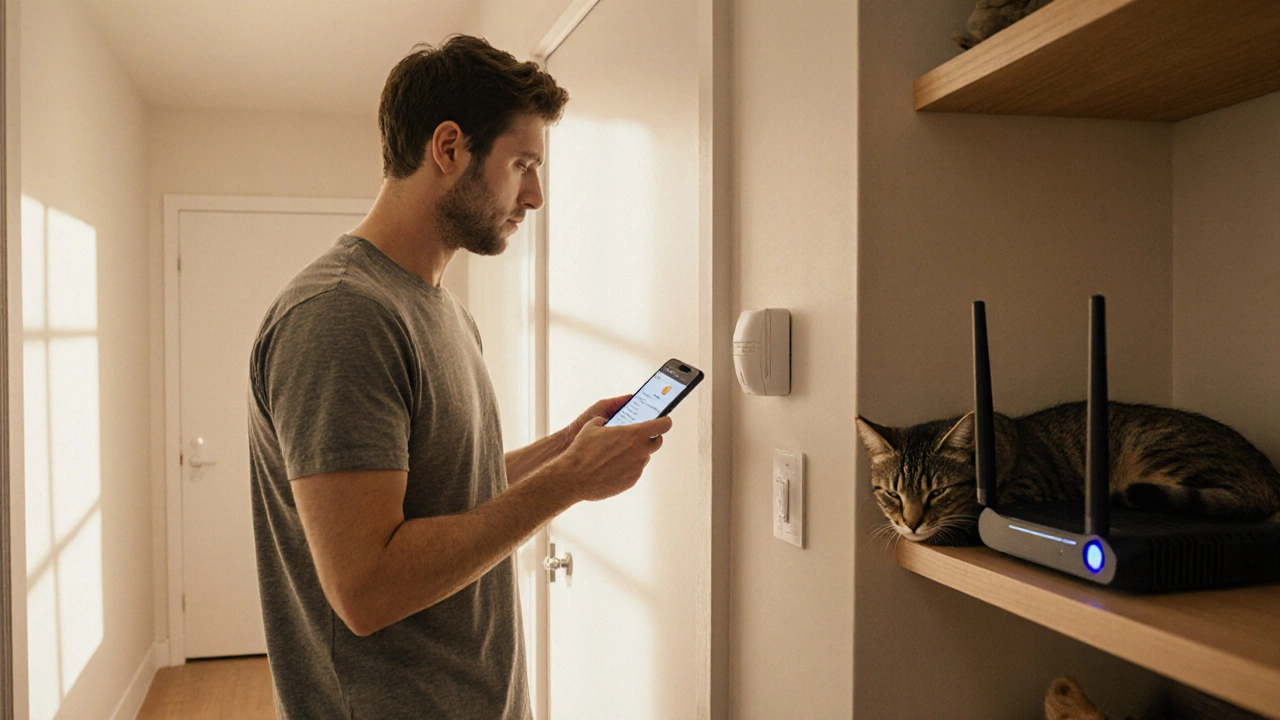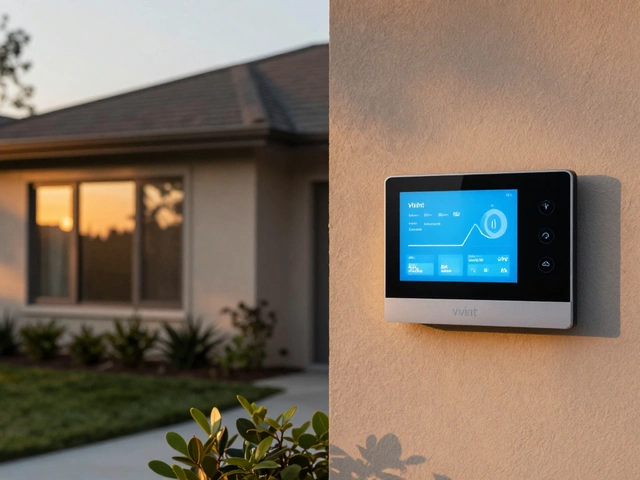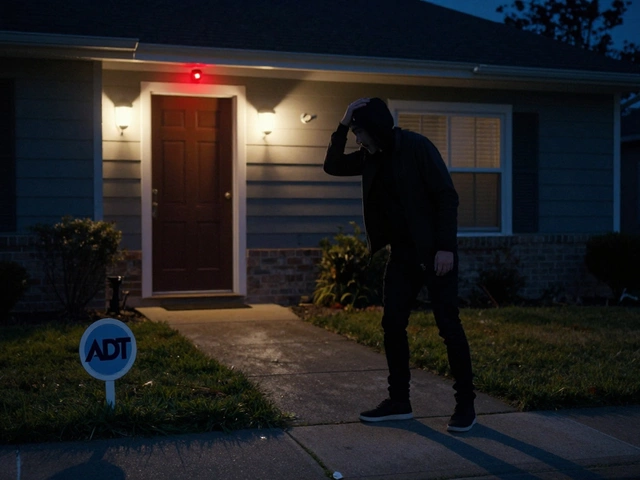Home Security System Calculator
Find Your Perfect ADT Alternative
Answer these quick questions to get personalized recommendations based on your priorities. No contracts, no hidden fees.
Paying a hefty monthly fee for a security system that ties you to a three‑year contract can feel like a trap. If you’ve stared at your ADT bill and wondered whether there’s a smarter, cheaper way to protect your home, you’re not alone. Below is a no‑fluff guide that walks you through what to look for, which brands deliver the most bang for your buck, and how to get everything up and running without a headache.
What ADT Actually Offers
ADT is a U.S.-based home security provider known for professional monitoring and long‑term contracts. Its core package includes a base station, door/window sensors, motion detectors, and a 24/7 monitoring service that routes alerts to a central dispatch center. The company’s reputation stems from its history-founded in 1874 as a fire‑protection service-and its nationwide technician network.
While ADT’s brand trust is hard to beat, the drawbacks are equally famous: pricey equipment, mandatory contracts, and limited self‑service options. Those pain points drive the growing market for best ADT alternative solutions that give you the same security level without the strings.
Key Criteria When Picking an ADT Alternative
- Contract flexibility: Does the system require a 12‑month or longer commitment?
- Monthly monitoring cost: How much will you pay for professional monitoring, and are there tiered plans?
- DIY installation: Can you set it up yourself, or do you need a technician?
- Smart home compatibility: Does it work with Alexa, Google Assistant, Apple HomeKit, or Zigbee/Z‑Wave ecosystems?
- Equipment price: Up‑front cost for sensors, cameras, and base stations.
- Pet‑friendly motion detection: Built‑in algorithms that ignore furry friends to reduce false alarms.
Using this checklist, you can quickly eliminate options that don’t match your lifestyle.
Top Five ADT Alternatives in 2025
Each of the following systems checks the boxes above, but they shine in different ways.
SimpliSafe is a DIY‑friendly, contract‑free home security suite with optional professional monitoring
- Monthly monitoring: $14.99 (no contract)
- Equipment: Starter kits start at $199, add‑on sensors $19 each
- Smart integration: Works with Alexa, Google Assistant, and Apple HomeKit
- Pet‑friendly: Motion sensors have a built‑in pet immunity setting
Vivint is a premium, professionally installed system that emphasizes home automation
- Monthly monitoring: $30 (includes smart home hub)
- Equipment: Custom packages start around $350; includes cameras, doorbells, and smart locks
- Smart integration: Alexa, Google Assistant, Apple HomeKit, and Z‑Wave
- Pet‑friendly: Advanced motion detection filters out pets up to 80 lb
Ring Alarm is an Amazon‑backed, affordable alarm system that ties directly into Ring video devices
- Monthly monitoring: $3 (self‑monitor) to $10 (professional)
- Equipment: Base kit $199, individual sensors $25
- Smart integration: Alexa native, works with Ring cameras and doorbells
- Pet‑friendly: Motion sensors configurable for pet size
Abode is a flexible, Z‑Wave‑centric system geared toward tech‑savvy users
- Monthly monitoring: $9 (professional) or free self‑monitor
- Equipment: Starter kit $299, premium cameras $149 each
- Smart integration: Alexa, Google Assistant, Apple HomeKit, Z‑Wave, IFTTT
- Pet‑friendly: Motion sensors include pet immunity toggle
Frontpoint is a customer‑service‑focused alarm system with easy DIY installation and transparent pricing
- Monthly monitoring: $19.99 (no contract)
- Equipment: Starter kit $229, add‑on sensors $20 each
- Smart integration: Alexa, Google Assistant, Apple HomeKit, and Zigbee
- Pet‑friendly: Motion sensors have a dedicated pet‑ignore mode
Side‑by‑Side Comparison
| Brand | Monthly Monitoring | Contract | Smart Home Compatibility | DIY Installation | Pet‑Friendly Motion |
|---|---|---|---|---|---|
| SimpliSafe | $14.99 | No | Alexa, Google, HomeKit | Yes | Yes |
| Vivint | $30 | 12‑month | Alexa, Google, HomeKit, Z‑Wave | No (pro install) | Yes (large pets) |
| Ring Alarm | $3‑$10 | No | Alexa, Ring ecosystem | Yes | Configurable |
| Abode | $9 (pro) / Free (self) | No | Alexa, Google, HomeKit, Z‑Wave, IFTTT | Yes | Yes |
| Frontpoint | $19.99 | No | Alexa, Google, HomeKit, Zigbee | Yes | Yes |
Which System Fits Your Lifestyle?
- Best budget pick: SimpliSafe - low upfront cost, no contract, solid monitoring.
- Best for renters: Ring Alarm - easy to remove, minimal drill work.
- Best for tech lovers: Abode - Z‑Wave hub, extensive IFTTT recipes.
- Best for full‑home automation: Vivint - integrates locks, lights, thermostats.
- Best customer support: Frontpoint - praised for live chat and phone help.

Step‑by‑Step DIY Installation Guide
- Plan your layout. Mark doors, windows, and high‑traffic zones on a floor plan. Keep sensors at least 5‑6 ft from the floor to avoid pets tripping them.
- Set up the base station. Plug it into a power outlet near your router, then follow the app’s QR‑code scan to connect it to Wi‑Fi.
- Mount sensors. Use the adhesive strips provided; for heavy‑duty doors, a small screw gives extra security.
- Pair devices. Open the system’s app, select "Add Device," and follow the on‑screen prompts. Most systems use BLE or Z‑Wave for quick pairing.
- Test each sensor. Trigger doors/windows, walk past motion detectors, and watch the app confirm the event.
- Enable monitoring. Choose a plan, enter payment info, and confirm the central station is online.
- Fine‑tune pet settings. If you have a cat or small dog, activate the "Pet Immunity" mode in the motion sensor settings to avoid false alarms.
Give yourself a weekend, and you’ll have a fully operational system without ever calling a technician.
Common Pitfalls and How to Avoid Them
- Weak Wi‑Fi signal. Place the base near the router or add a Wi‑Fi extender; a 2.4 GHz band is more reliable for smart devices.
- Battery neglect. Most sensors run on AA or CR123 batteries that last 2‑5 years. Set a calendar reminder to replace them before they die.
- Forgotten pet mode. New owners often skip the pet‑immunity toggle and get annoyed by nightly alerts. Double‑check the setting after each motion sensor installation.
- Over‑reliance on self‑monitoring. If you travel often, consider upgrading to a professional plan; the cost difference is usually under $10 per month.
Future‑Proofing Your Home Security
Smart home standards evolve fast. When picking a system, ask whether the manufacturer releases OTA firmware updates and how often they add new device compatibility. Systems built on open protocols like Z‑Wave or Zigbee (e.g., Abode) give you the most flexibility to add new sensors, smart locks, or even third‑party cameras down the line.
Is a professional monitoring service worth the extra cost?
If you want 24/7 emergency response that contacts police or fire services automatically, professional monitoring is essential. For most homeowners, the added $5‑$15 per month offers peace of mind that self‑monitoring can’t match.
Can I keep my existing smart lights when switching from ADT?
Yes. Most modern alarm kits speak the same protocols (Z‑Wave, Zigbee, or Wi‑Fi) that smart bulbs use. Just add the lights to the new app and assign them to scenes or automation rules.
Do I need a separate hub for Z‑Wave devices?
Many all‑in‑one alarm panels, like Abode, include a built‑in Z‑Wave hub. If your chosen system doesn’t, you’ll have to buy a standalone hub (e.g., Samsung SmartThings) for compatibility.
How do I cancel an ADT contract if I switch?
ADT typically requires a 30‑day notice and may charge an early‑termination fee (often $99‑$149). Check your agreement, then call the customer service line, request a cancellation confirmation in writing, and keep the record.
Which system offers the best pet‑friendly motion detection?
Vivint’s motion sensors have a proprietary algorithm that distinguishes pets up to 80 lb, making it the most reliable option for larger cats or dogs. SimpliSafe and Abode also have good pet‑ignore modes, but they rely on a simple height threshold.






